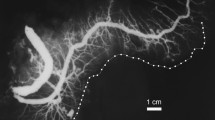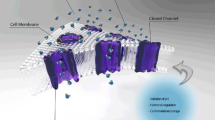Abstract
The fine structure of the main excretory duct epithelium (MEDE) of female mouse submandibular gland was investigated by scanning and transmission electron microscopy and the results compared with the previously established structure of male mouse MEDE. A comparative analysis of the subepithelial capillaries of both sexes was also performed. In this pseudostratified epithelium, principal cell-types were observed: types-I,-II,-III and basal cells. This differed significantly from male MEDE, where type-II and-III are absent and type-I cells are the most numerous. The latter cell-type had abundant mitochondria, a few lipid-containing granules, lysosomes in the infra-nuclear cytoplasm and well-developed basal infoldings. These cells were also characterized by abundant glycogen granules throughout the cytoplasm, many profiles of strands of smooth endoplasmic reticulum in the apical region, and lysosomes in the infra-nuclear region. Type-II cells were the second most numerous. Their most characteristic features were the presence of tubular vesicles which appeared to be invaginated from the plasma membrane, RER, SER, free ribosomes, a few peroxisomes with nucleoids, and primary lysosomes in extremely light cytoplasm. They had many mitochondria throughout the cytoplasm, except in the apical region, a few lipid-containing granules and no basal infoldings. Type-III cells were very few and were characterized by well developed basal infoldings, abundant free ribosomes, RER, SER, vesicles containing moderately dense material, and many lipid-containing granules. They also had many mitochondria throughout the cytoplasm, except apically. Basal cells had a large nucleus and the cytoplasm had few organelles. In the male continuous capillaries predominated in the subepithelial network, and capillary density per 200 μm of epithelium (3.76±1.54) was lower than in the female, as was the number of fenestrae per 10 μm of available endothelium (4.46±1.71). In the female, fenestrated capillaries predominated, and the capillary density per 200 μm of epithelium was 6.76 (±1.54), and the number of fenestrae per 10 μm of available endothelium was 4.91 (±1.77).
Similar content being viewed by others
References
Angeletti PU, Salvi ML, Tacckini G (1964) Inhibition of the testosterone effect on the submaxillary gland by actiomycin-D. Experientia 20:612–613
Borst P (1986) How proteins get into microbodies (peroxisomes, glyoxysomes, glycosomes). Biochim Biophys Acta 866:179–203
Burgen ASV, Seeman P (1958) The role of the salivary duct system in the formation of the saliva. Can J Biochem Physiol 36:119–143
Caramia F (1966) Ultrastructure of mouse submaxillary gland. I. Sexual differences. J Ultrastruct Res 16:505–523
Clough G, Smaje LH (1984) Exchange area and surface properties of the microvasculature of the rabbit submandibular gland following duct ligation. J Physiol 354:445–456
Duve C de, Baudhuin P (1966) Peroxisomes. Physiol Reviews 46:323–357
Fekete E (1941) Histology. In: Snell GD (ed) The biology of the laboratory mouse. Blakiston, Philadelphia, pp 89–167
Fujita M, Yamamoto T (1984) Selective demonstration by tannic acid of a special cytoplasmic tubular system in the chloride cells of teleost gills. Arch Histol Jpn 47:113–118
Gresik EW (1966) A previously unreported cell type in female mouse submandibular glands. J Cell Biol 31:144A
Gresik EW, MacRae EK (1975) The postnatal development of the sexually dimorphic duct system and of amylase activity in the submandibular glands of mice. Cell Tissue Res 157:411–422
Hand AR (1973) Morphologic and cytochemical identification of peroxisomes in the rat parotid and other exocrine gland. J Histochem Cytochem 21:131–141
Henderson JR, Moss MC (1985) A morphometric study of the endocrine and exocrine capillaries of the pancreas. Q J Exp Physiol 70:347–356
Hosoi K, Kobayashi M, Hiramatsu N, Minami N, Ueha T (1979) Androgenic regulation of N-acetyl-glucosaminidase activity in the submaxillary gland of mice. J Biochem 85:1483–1488
Hruban Z, Rechcigl M (1969) Microbodies and related particles: Microbodies of various animal species. Int Rev Cytol [Suppl] 1:20–59
Karnaky KJ Jr, Ernst SA, Philpott CW (1976a) Teleost chloride cell. I. Response of pupfish Cyprinodom variegatus gill Na, K-ATPase and chloride cell fine structure to various high salinity environments. J Cell Biol 70:144–156
Karnaky KJ Jr, Kinter LB, Kinter WB, Stirling CE (1976b) Teleost chloride cell. II. Autoradiographic localization of gill Na, K-ATPase in killifish Fundulus heteroclitus adapted to low and high salinity environments. J Cell Biol 70:157–177
Karnovsky MJ (1967) The ultrastructural basis of capillary permeability studied with peroxidase as a tracer. J Cell Biol 35:213–236
Karnovsky MJ (1971) Use of ferrocyanide-reduced osmium tetroxide in electron microscopy. 14th Annual Meeting Am Soc Cell Biol, p 146
Kindl H (1982) The biosynthesis of microbodies (Peroxisomes, Glyoxysomes). Int Rev Cytol 80:193–229
Komuro T, Yamamoto T (1975) The renal chloride cell of the fresh-water catfish, Parasilurus asotus, with special reference to the tubular membrane system. Cell Tissue Res 160:263–271
Lacassagne A (1940) Dimorphism sexuel de la glande sousmaxillaire chez la souris. CR Soc Biol 133:180–181
Lazarow PB, Duve C de (1976) A fatty acyl-CoA oxidizing system in rat liver peroxisomes; enhancement by clofibrate, a hypolipidemic drug. Proc Natl Acad Sci USA 73:2043–2046
Mizuhira V, Amakawa T, Yamashina S, Shirai N, Uchida S (1970) Electron microscopic studies on the localization of sodium ions and sodium-potassium-activated adenosinetriphosphatase in chloride cells of eel gills. Exp Cell Res 59:346–348
Nakamura T, Fujji M, Kaiho M, Kumegawa M (1974) Sex difference in glucose-6-phosphate dehydrogenase activity in the submaxillary gland of mice. Biochim Biophys Acta 362:110–120
Napolitano L, Lebaron F, Scaletti J (1967) Preservation of myelin lamellar structure in the absence of lipids. J Cell Biol 34:817–826
Oliver WJ, Gross F (1967) Effect of testosterone and duct ligation on submaxillary renin-like principle. Am J Physiol 213:341–346
Sato A, Miyoshi S (1988) Ultrastructure of the main excretory duct of the rat parotid and submandibular glands with a review of the literature. Anat Rec 220:239–251
Sato A, Miyoshi S (1990) Morphometric study of the microvasculature of the main excretory duct subepithelia of the rat parotid. submandibular and sublingual salivary glands. Anat Rec 226:288–294
Sato A, Miyoshi S (1992) Occurrence of unusual heterogeneous lipid-containing granule storing cells in the main excretory duct epithelium of the male mouse submandibular gland. Cell Tissue Res 268:31–40
Sawada K, Noumura T (1991) Effects of castration and sex steroids on sexually dimorphic development of the mouse submandibular gland. Acta Anat 140:97–103
Schneyer LH (1968) Secretory processes in perfused excretory duct of rat submaxillary gland. Am J Physiol 215:664–670
Schneyer LH (1969) Secretion of potassium by perfused excretory duct of rat submaxillary gland. Am J Physiol 217:1324–1329
Schneyer LH, Young JA, Schneyer CA (1972) Salivary secretion of electrolytes. Physiol Rev 52:720–777
Shirai N, Utida S (1970) Development and degeneration of the chloride cells during seawater and freshwater adaptation of the Japanese eel, Anguilla japonica. Z Zellforsch 103:247–264
Simionescu N, Simionescu M, Palade GE (1973) Permeability of muscle capillaries to exogenous myoglobin. J Cell Biol 57:424–452
Young JA, Frömter E, Schögel E, Hamann KF (1967) A microperfusion investigation of sodium resorption and potassium secretion by the main excretory duct of the submaxillary gland. Pflüger Arch Ges Physiol 295:157–172
Author information
Authors and Affiliations
Rights and permissions
About this article
Cite this article
Sato, A., Goto, F. & Miyoshi, S. Ultrastructure of the main excretory duct epithelium of the female mouse submandibular gland with special reference to sexual dimorphism. Cell Tissue Res 277, 407–415 (1994). https://doi.org/10.1007/BF00300213
Received:
Accepted:
Issue Date:
DOI: https://doi.org/10.1007/BF00300213




